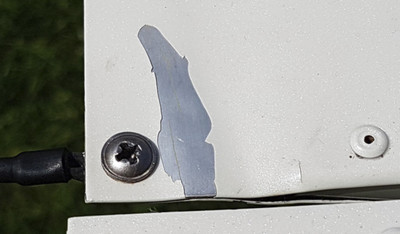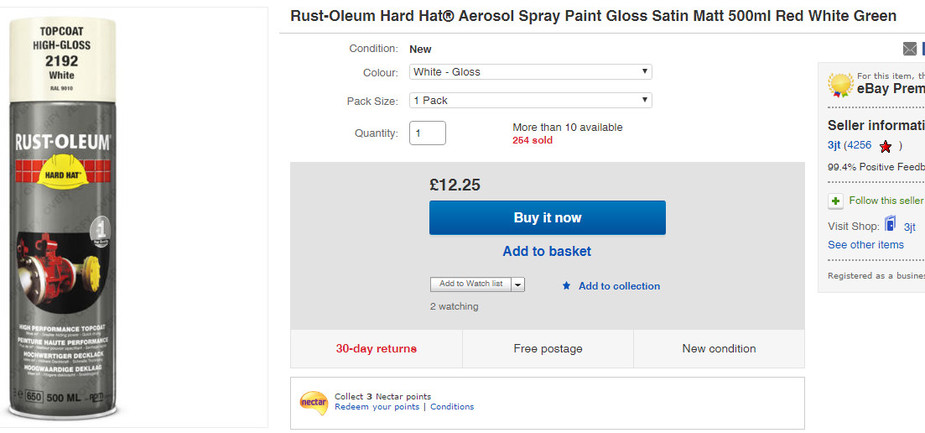
This happened some time ago, and initially the paint was just cracked, where the corrosion line shows on the aluminium.
Recently I saw the paint coming off so I pulled off what I could easily.
What do people use to touch this up? In theory one should
That’s a lot of work.
There are some “direct to metal” paints but most of them simply don’t seem to work. The original one was Hammerite but I have seen that come right off pretty quick. Epoxy is good but has no UV resistance so needs at least a UV lacquer.
Car repairs are done with a 2K primer (2 pack), 2K base colour (1 pack), 2K lacquer (2 pack). This is great stuff but very toxic and needs a lot of skill.
Peter wrote:
There are some “direct to metal” paints but most of them simply don’t seem to work.
I will ask our technicians what they use when I am at work next time. I see them all the time touching up stuff on the aeroplanes. Pressurised hulls always develop cracks around the rivets of the fuselage and the radomes (which are not of metal but glassfiber) need a touch up after every flight through a heavy shower. AFAIK they don’t etch or prime or anything but simply apply paint.
On that picture (but pictures can lie), it doesn’t look alodined nor primed, or it wouldn’t just crack up like that leaving the bare metal (it could be very poorly done of course). Before you start with alodine and stuff, be sure the alloy is 2024. If it’s 6061 or perhaps 6082, then alodine will not do any good, it could even degrade the inherent corrosion performance of the alloy.
It looks like you have a crack in the metal?
Corrosion needs 3 things:
You also need a galvanic potential, but unless we are talking “pure” galvanic corrosion (dissimilar metals, “real” electric potentials etc), the metal and electrolyte usually creates that on it’s own.
Getting rid of one of them, will stop corrosion. I don’t see the reason for overdoing a touch up. You really only want to cover the metal, stop it from spreading.I would just pick off all the loose paint, sand it and apply a good coat of Power Coat, (industrial paint, 1 K, that is used in the North Sea to paint all kinds of metals) but that’s me  The only way to really fix it is to strip the old paint and repaint the whole part in any case.
The only way to really fix it is to strip the old paint and repaint the whole part in any case.
LeSving wrote:
You also need a galvanic potential, but unless we are talking “pure” galvanic corrosion …
The galvanic potential is clearly there with that stainless steel screw fixing the static wick (some of which contain carbon fibres as conductors which makes things even worse) to the aluminium control surface. Then there is also a pop rivet which is made from a different alloy than the sheet metal. It doesn’t help either that water can be trapped in there… These are the corners where every aircraft sooner or later will develop corrosion, no matter what corrosion proofing, primer or paint are applied. Last year “my” little Citation needed a new elevator and one new aileron because of hidden corrosion underneath the static wicks and inside.
It doesn’t feel like a crack. If I push down on the edge (so as to open up the crack) nothing at all is felt with a fingernail.
It was primed but, hey, by Socata, whose multi million € spray bay has the temperature, humidity and operator red wine consumption controlled by a random number generator – or at least it did in those days… I have seen TBMs with large chunks of paint peeling right off around the filler caps, and mine peeled off years ago so I made the protective disks. Socata use the MAPAERO system – primer, base, UV lacquer (the lacquer, on mine, has fine “pearlscent” metal flakes in it) and it is all 2-pack. I have some here but it was a bastard to obtain (MAPAERO doesn’t want to sell to anybody, and eventually Socata brought me some from France on a visit here), it is a bastard to apply well, and doesn’t colour match anyway due to the upper paint having faded over 15 years. I know UK spray shops hate that paint and use another one; I don’t recall which.
Your paint suggestion looks similar to this stuff which does seem to work very well so far in other uses, although obviously makes a messy job if applied with a brush

The Power Coat paint seems to exist only in Norway
The wick is copper inside – just a normal wire. The rivet should be an aluminium rivet. And the gap between the sheets should be comprehensively filled with ACF50 – it oozes out on every flight 
Peter wrote:
The wick is copper inside – just a normal wire.
But copper, aluminium and water will also form a galvanic element with aluminium being the “weakest” part. Keep it as dry as possible then… Our control surfaces were also filled with corrosion block but all that did was delay the corrosion for some time.
OK; I need to understand more about this.
The copper wire is enclosed in the M4 solder tag, which is plated … copper! But I can get a stainless steel one. Or put a suitable (conductive) washer between the two. The philips screw is stainless for sure; probably 304.
However I have not seen any corrosion around these solder tags, or near rivets. Socata uses loads of stainless steel structural rivets, which many people criticise severely for starting corrosion (especially the recent infamous elevator AD which followed some elevator spars reduced to defoliated shreds – prob99 as a result of control “locks” being elastic bands tying the yoke to the seat and preventing drain holes working) but could Socata be so dumb?
Anyway, in this case, there is no apparent corrosion around the screw or the rivet.
Rub back to good metal, to get rid of the corrosion.
Treat the area with alocrome ( please read the H&S data, its nasty stuff )
Etch primer
Top coat paint finish.
Lacquer if required.
This all assumes that the line in the photo is not a crack !
Thank you all.
That Norwegian 3 in 1 paint is not practically available outside Norway – the usual “hazardous” reason for expensive shipping. If it was on Ebay it would be fine; Ebay sellers routinely send aerosol cans by airmail 
Shipping by Schenker for 2 spray cans (ca. 1 kg) will be £244 (£140 of which is because paint is considered dangerous goods). The paint itself will be £20 per can, £40 total.
Peter wrote:
Socata uses loads of stainless steel structural rivets, which many people criticise severely for starting corrosion
Sonex use SS rivets on all their planes. SS and aluminium is usually a safe and good combination. The only exception is salt water, then the galvanic potential comes into full force (SS is very “noble”, aluminium is not). The problem is very well known from boating, and the solution is called Duralac. An aircraft will seldom experience salt spray like a boat does, where things often are are completely soaked in salt water, but I have used Duralac on all my rivets on my Onex. Duralac protects by sealing the joint, preventing water to enter in between, and by being chromated (barium chromate). There are other non chromated joint sealants around, they probably work just as good, if not better than Duralac (I think I remember 3M makes one), but I guess the psychological factor of barium chromate is strong  In my head, the physical properties, flexibility over time and so on should be more important. Anyway, that was what I was recommended by salt water trenched sailers, and I had no reason to doubt them anyway. Duralac is originally made for aviation, but is more used in boating today (used for rivets, bolts, screws, everywhere when aluminium is in contact with other metal).
In my head, the physical properties, flexibility over time and so on should be more important. Anyway, that was what I was recommended by salt water trenched sailers, and I had no reason to doubt them anyway. Duralac is originally made for aviation, but is more used in boating today (used for rivets, bolts, screws, everywhere when aluminium is in contact with other metal).
The process is called wet riveting (dipping the rivets in primer or sealant), and is also used for pressurized airframes, tanks and so on. I think the US Navy specify wet riveting on all airframe parts, to prevent corrosion. I think the F-16s are all wet riveted as well, but not sure.
I think, one point here for bolts and screws (not so much rivets perhaps), is that in a marine environment close to the shore, ordinary structural steel does not work very well. It will start to rust rather fast. There is no danger in this, bolts and screws can simply be replaced, but it is a nuisance to replace screws every other year and it looks ugly. Lots of bolts and screws are difficult or impossible to get to also. SS is the only way to go, but the problem now is that if corrosion starts, it will be the aluminium structure that corrodes due to galvanic corrosion. The airframe structure is more problematic to replace than a bolt  The (corrosive) environment where you would like to use SS, is the same environment where SS and aluminium is not a particularly good combination. SS and aluminium should therefore always be joined “wet”.
The (corrosive) environment where you would like to use SS, is the same environment where SS and aluminium is not a particularly good combination. SS and aluminium should therefore always be joined “wet”.
The Sonex company is situated in Oshkosh, far inland in other words. No traces of marine environment there (even though its’s close to a huge fresh water lake). They use 6061 alloy exclusively, combined with SS rivets. The reason is that such an aircraft can stay un-primed and unpainted for centuries without a single trace of corrosion. It’s a excellent and simple solution. But, they obviously have no clue whatsoever what a marine environment is. My home airport extends into the fjord for instance, and salt water is sprayed all over the airport facilities in windy conditions. Still, SS and 6061 are excellent alloys here as well. The best there is in fact, the same materials are used for masts and other structural components on deck of sail boats (hulls are usually made of 5 series aluminium alloy). You just have to remember the joints, they need to be protected, or the choice of materials will be wasted.